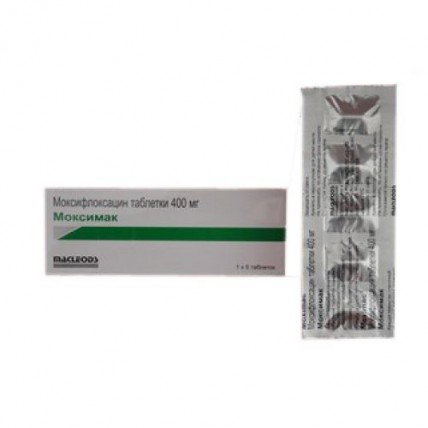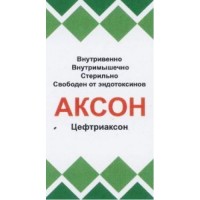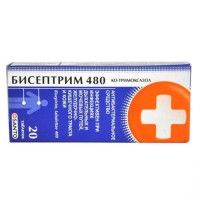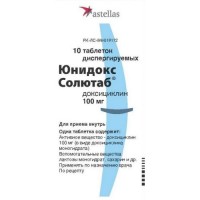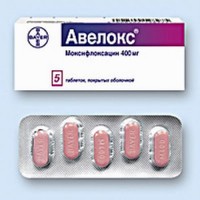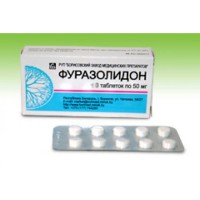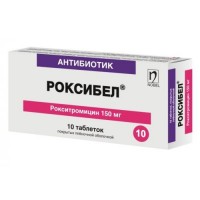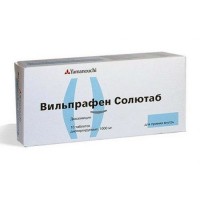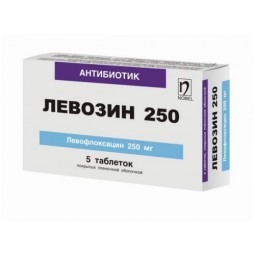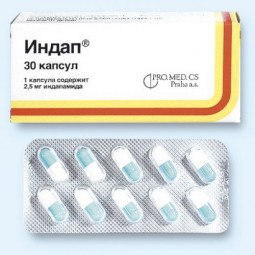Moksimak 5's 400 mg film-coated tablets
- $34.30
The instruction for use
of medicine for experts
of MOKSIMAK
the Trade name
Moksimak
Mezhdunarodnoye the unlicensed
name Moxifloxacin Dosage Form
of the Tablet, film coated, 400 mg
Structure
One tablet contains
active agent - a moksifloksatsina a hydrochloride
is equivalent a moksifloksatsina of 400 mg,
excipients: microcrystalline cellulose, lactoses monohydrate, L-hydroxypropyl cellulose, croscarmellose sodium, magnesium stearate,
structure of a cover: a hydroksipropilmetiltsellyuloza, polyethyleneglycol-6000, the titan dioxide, the purified talc, dye ferrous oxide red, benzyl alcohol.
Pharmacotherapeutic group and
Antibacterial drugs – derivatives of a ftorkhinolon
of Ftorkhinolona.
The code of automatic telephone exchange J01MA14
the Pharmacological
Pharmacokinetics Absorption Later properties of intake moxifloxacin is well soaked up from digestive tract. The absolute bioavailability is about 90%. Average value of the maximum concentration Cmax ± SD (SD – a standard deviation) and AUC value at a dosage of 400 mg make 4.5 ± 0.53 mkg/ml and 48 ± 2.7 mkg/hour/ml, respectively once a day. Cmax (maximum concentration) is reached in 1 - 3 hour after intake. Average plasma (± SD) concentration makes 4.95 ± 0.10 mkg/ml. Plasma concentration increases in proportion to increase in a dose to the highest studied dose (800 mg once). Average elimination half-life (± SD) made of plasma 12 ± 1.3 hours, resistant values are reached at least in three days of reception on 400 mg once a day.
Metabolism
Moxifloxacin is metabolized by conjugation to a glucuronide and sulfate. The sulphatic conjugate (M1) makes about 38% of a dose, is removed generally with a stake. About 14% of a dose turn into a glyukuronidny conjugate (M2) which is removed only with urine. Peak plasma concentration of M2 make about 40% of initial substance while plasma concentration of M1 usually make less than 10% of not changed moksifloksatsin.
Removal
About 45% of an oral or intravenous dose of a moksifloksatsin is removed in the form of not changed substance (20% - with urine and 25% - with a stake). In general 96% ± 4% of the accepted oral dose are removed in the form of not changed substance or metabolites. Average (± SD) the general clearance and renal clearance are 12 ± 2.0 l/hour and 2.6 ± 1.5 l/hour, respectively.
The pharmacodynamics
Moksimak shows bactericidal action as a result of inhibition of topoisomerase II (DNK-girazy) and topoisomerases IV necessary for replication, a transcription, a reparation and a recombination of bacterial DNA. The mechanism of action of hinolon, including moxifloxacin, differs from the mechanism of action of macroleads, beta laktamnykh antibiotics, aminoglycosides and tetracyclines therefore the microorganisms resistant to these classes of drugs can be sensitive to a moksimak and other hinolona. Cross stability between moksimaky and other classes of germicides was not noted.
Moxifloxacin is active concerning the majority of strains of the following microorganisms
- aerobic gram-positive microorganisms: Staphylococcus aureus (only the strains sensitive to Methicillinum), Streptococcus pneumoniae (the strains sensitive to penicillin)
- aerobic gram-negative microorganisms: Haemophilus influenzae, Klebsiella pneumoniae, Haemophilus parainfluenzae, Moraxella catarrhalis
- other microorganisms: Chlamydia pneumoniae, Mycoplasma pneumoniae.
Indications
- acute bacterial sinusitis
- exacerbation of chronic bronchitis
- community-acquired pneumonia (easy and moderately severe).
The route of administration and doses
Moxifloxacin of a tablet accept on one tablet 400 mg inside each 24 hours. Duration of treatment depends on infection type as it is described below:
The infection
the Daily dose
treatment Duration
Acute bacterial sinusitis
of 400 mg
of 5-7 days
Exacerbation of chronic bronchitis
of 400 mg
of 5 days
Community-acquired pneumonia
of 400 mg
of 5-7dny
Dose adjustment with a liver failure of easy or average degree is not required from patients.
Side effects
- nausea, diarrhea, an abdominal pain, vomiting, change of taste
- change of functional indicators of a liver
- dizziness,
the Contraindication headache
- hypersensitivity in the anamnesis to a moksifloksatsin or any antibacterial drug from group of hinolon
- pregnancy, breastfeeding
- children's and youthful age up to 18 years
Medicinal interactions
the assessment of pharmacokinetic medicinal interaction of a moksimak with theophylline, warfarin, digoxin, probenetsidy, ranitidine, Glyburidum, iron preparations and antacids Was carried out. Clinically significant action of a moksimak on pharmacokinetics of theophylline and Glyburidum was not noted. Theophylline, digoxin, probenetsid and ranitidine did not influence pharmacokinetics of a moksifloksatsin. However, as well as in a case with all other hinolona, iron preparations and antacids considerably reduced bioavailability of a moksimak.
Special indications
of Feature of influence of medicine on ability to run transport or potentially dangerous mechanisms
Considering side effects of drug, it is necessary to be careful at control of transport or potentially dangerous mechanisms
Overdose
Symptoms - strengthening of side effects is possible.
Treatment - gastric lavage, prescribing of activated carbon and symptomatic therapy.
Form of release and packing
of the Tablet, film coated, 400 mg No. 4.
Primary packing: a strip from aluminum foil on 4 tablets.
Secondary packing: 1 strip in cardboard packing.
Tablets, film coated, 400 mg No. 5.
Primary packing: a strip from aluminum foil on 5 tablets.
Secondary packing: 1 strip in cardboard packing.
To Store storage conditions in dry, protected from light, the place at a temperature not over 250C.
To store out of children's reach!
24 months
not to apply a period of storage after an expiration date.
Prescription status
According to the prescription
Macleods Pharmaceuticals Limited Producer
304, Atlanta Arcade, Marol Church Road, Andheri (East), Mumbai – 400,059
India.
of medicine for experts
of MOKSIMAK
the Trade name
Moksimak
Mezhdunarodnoye the unlicensed
name Moxifloxacin Dosage Form
of the Tablet, film coated, 400 mg
Structure
One tablet contains
active agent - a moksifloksatsina a hydrochloride
is equivalent a moksifloksatsina of 400 mg,
excipients: microcrystalline cellulose, lactoses monohydrate, L-hydroxypropyl cellulose, croscarmellose sodium, magnesium stearate,
structure of a cover: a hydroksipropilmetiltsellyuloza, polyethyleneglycol-6000, the titan dioxide, the purified talc, dye ferrous oxide red, benzyl alcohol.
Pharmacotherapeutic group and
Antibacterial drugs – derivatives of a ftorkhinolon
of Ftorkhinolona.
The code of automatic telephone exchange J01MA14
the Pharmacological
Pharmacokinetics Absorption Later properties of intake moxifloxacin is well soaked up from digestive tract. The absolute bioavailability is about 90%. Average value of the maximum concentration Cmax ± SD (SD – a standard deviation) and AUC value at a dosage of 400 mg make 4.5 ± 0.53 mkg/ml and 48 ± 2.7 mkg/hour/ml, respectively once a day. Cmax (maximum concentration) is reached in 1 - 3 hour after intake. Average plasma (± SD) concentration makes 4.95 ± 0.10 mkg/ml. Plasma concentration increases in proportion to increase in a dose to the highest studied dose (800 mg once). Average elimination half-life (± SD) made of plasma 12 ± 1.3 hours, resistant values are reached at least in three days of reception on 400 mg once a day.
Metabolism
Moxifloxacin is metabolized by conjugation to a glucuronide and sulfate. The sulphatic conjugate (M1) makes about 38% of a dose, is removed generally with a stake. About 14% of a dose turn into a glyukuronidny conjugate (M2) which is removed only with urine. Peak plasma concentration of M2 make about 40% of initial substance while plasma concentration of M1 usually make less than 10% of not changed moksifloksatsin.
Removal
About 45% of an oral or intravenous dose of a moksifloksatsin is removed in the form of not changed substance (20% - with urine and 25% - with a stake). In general 96% ± 4% of the accepted oral dose are removed in the form of not changed substance or metabolites. Average (± SD) the general clearance and renal clearance are 12 ± 2.0 l/hour and 2.6 ± 1.5 l/hour, respectively.
The pharmacodynamics
Moksimak shows bactericidal action as a result of inhibition of topoisomerase II (DNK-girazy) and topoisomerases IV necessary for replication, a transcription, a reparation and a recombination of bacterial DNA. The mechanism of action of hinolon, including moxifloxacin, differs from the mechanism of action of macroleads, beta laktamnykh antibiotics, aminoglycosides and tetracyclines therefore the microorganisms resistant to these classes of drugs can be sensitive to a moksimak and other hinolona. Cross stability between moksimaky and other classes of germicides was not noted.
Moxifloxacin is active concerning the majority of strains of the following microorganisms
- aerobic gram-positive microorganisms: Staphylococcus aureus (only the strains sensitive to Methicillinum), Streptococcus pneumoniae (the strains sensitive to penicillin)
- aerobic gram-negative microorganisms: Haemophilus influenzae, Klebsiella pneumoniae, Haemophilus parainfluenzae, Moraxella catarrhalis
- other microorganisms: Chlamydia pneumoniae, Mycoplasma pneumoniae.
Indications
- acute bacterial sinusitis
- exacerbation of chronic bronchitis
- community-acquired pneumonia (easy and moderately severe).
The route of administration and doses
Moxifloxacin of a tablet accept on one tablet 400 mg inside each 24 hours. Duration of treatment depends on infection type as it is described below:
The infection
the Daily dose
treatment Duration
Acute bacterial sinusitis
of 400 mg
of 5-7 days
Exacerbation of chronic bronchitis
of 400 mg
of 5 days
Community-acquired pneumonia
of 400 mg
of 5-7dny
Dose adjustment with a liver failure of easy or average degree is not required from patients.
Side effects
- nausea, diarrhea, an abdominal pain, vomiting, change of taste
- change of functional indicators of a liver
- dizziness,
the Contraindication headache
- hypersensitivity in the anamnesis to a moksifloksatsin or any antibacterial drug from group of hinolon
- pregnancy, breastfeeding
- children's and youthful age up to 18 years
Medicinal interactions
the assessment of pharmacokinetic medicinal interaction of a moksimak with theophylline, warfarin, digoxin, probenetsidy, ranitidine, Glyburidum, iron preparations and antacids Was carried out. Clinically significant action of a moksimak on pharmacokinetics of theophylline and Glyburidum was not noted. Theophylline, digoxin, probenetsid and ranitidine did not influence pharmacokinetics of a moksifloksatsin. However, as well as in a case with all other hinolona, iron preparations and antacids considerably reduced bioavailability of a moksimak.
Special indications
of Feature of influence of medicine on ability to run transport or potentially dangerous mechanisms
Considering side effects of drug, it is necessary to be careful at control of transport or potentially dangerous mechanisms
Overdose
Symptoms - strengthening of side effects is possible.
Treatment - gastric lavage, prescribing of activated carbon and symptomatic therapy.
Form of release and packing
of the Tablet, film coated, 400 mg No. 4.
Primary packing: a strip from aluminum foil on 4 tablets.
Secondary packing: 1 strip in cardboard packing.
Tablets, film coated, 400 mg No. 5.
Primary packing: a strip from aluminum foil on 5 tablets.
Secondary packing: 1 strip in cardboard packing.
To Store storage conditions in dry, protected from light, the place at a temperature not over 250C.
To store out of children's reach!
24 months
not to apply a period of storage after an expiration date.
Prescription status
According to the prescription
Macleods Pharmaceuticals Limited Producer
304, Atlanta Arcade, Marol Church Road, Andheri (East), Mumbai – 400,059
India.
